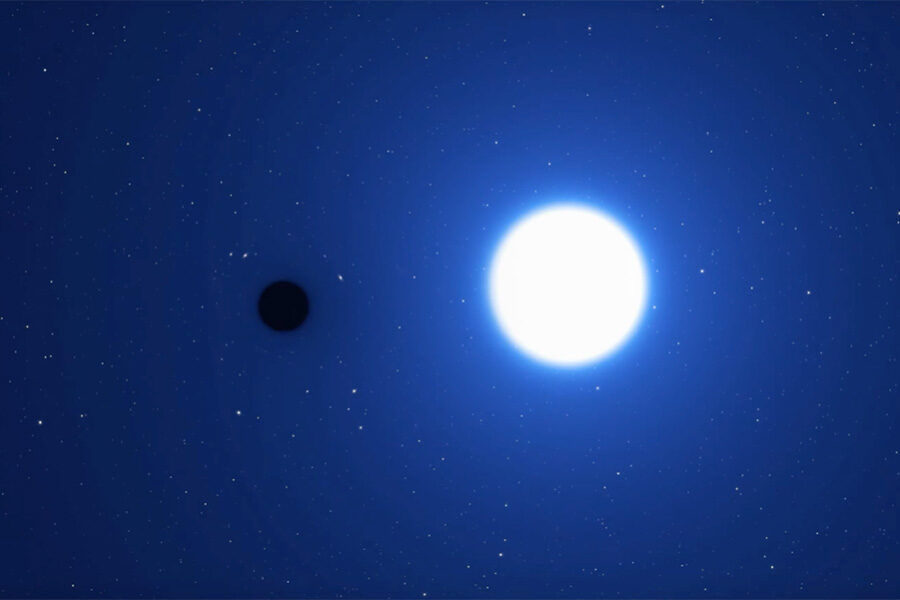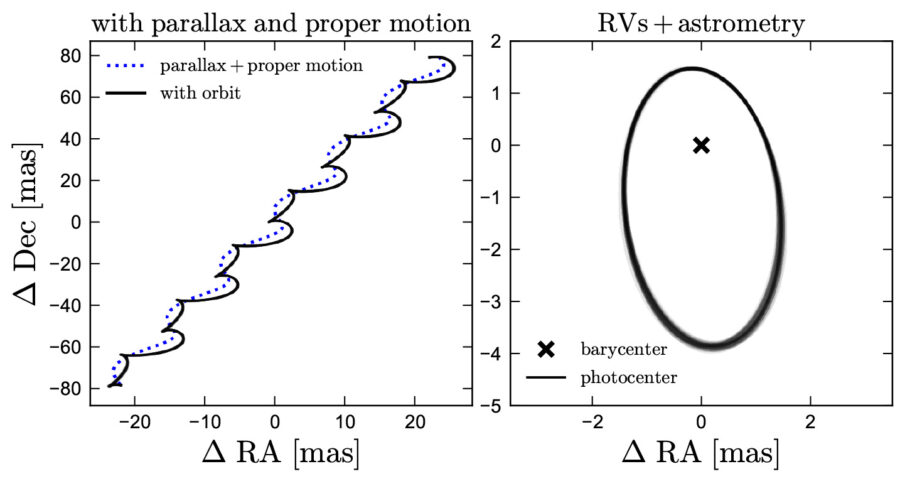The most compelling dormant stellar-mass black hole candidate in the Milky Way orbits a Sun-like star only 1,570 light-years away.

ESO / L. Calçada
The Milky Way probably contains a whopping 100 million stellar-mass black holes. But even though they’re ubiquitous, they’re notoriously difficult to find — which is not surprising because they are, well, black.
But black holes do have gravity, and they know how to use it. If a black hole has a stellar companion, and they orbit each other closely enough, the former can strip some of the gas from the star. The gas falling into the black hole heats up and shines in high-energy radiation. Astronomers have found more than 50 such systems in the Milky Way.
However, when a black hole and its companion star orbit each other at a greater distance, the star remains whole. The black hole is then dormant and much more challenging to spot. To find it, one has to search for wobbling stars whose peculiar motion could be due to an unseen dark companion.
This is how a team of astronomers discovered the newest black hole candidate, which they call Gaia BH1. (The study, which is under review, is available here). Although it isn’t the first proposed candidate of its kind, it seems to be the most compelling to date.
A Most Unremarkable Star and Its Black Hole Buddy
The Gaia BH1 system consists of a black hole almost 10 times more massive than the Sun, and a companion star that resembles the Sun. The pair circle each other roughly every half-year.
Finding the system wasn't easy. Black holes accompany only a small fraction of stars, so astronomers need to monitor the positions of millions of stars for years on end to find such a system. And, as the star and black hole circle each other, they each trace a small ellipse on the sky, a tiny motion that requires phenomenal precision to detect.
"We can only do this because the Gaia data set exists," says Kareem El-Badry (Center for Astrophysics, Harvard & Smithsonian and Max Planck Institute for Astronomy, Germany), who led the new study. The European Space Agency’s Gaia spacecraft is on a mission to precisely monitor the positions of more than 2 billion stars in our Galaxy. A recently released catalog contains almost 170,000 wiggling stars. Most of these are binaries composed of normal stars, but some could be harboring a black hole.
El-Badry and collaborators sifted through the treasure trove and found a handful of black hole candidates. To validate the finds, they dug up spectra taken as part of the LAMOST survey and obtained additional spectra of their own. As a star in a binary moves toward and away from us, known as its radial velocity, its spectrum also shifts. For only one of the candidates — Gaia BH1 — the radial velocity changes and Gaia's ellipse observations match, making it a strong black hole candidate.
“They have a very concise set of evidence because they have astrometry and radial velocity information which independently point to the same conclusion,” says Tomer Shenar (University of Amsterdam), who wasn’t involved in the study.

Kareem El-Badry et al. / arXiv.org:2209.06833
Researchers have a hard time explaining how a Sun-like star came to be tied to a massive black hole. “Low-mass stars bound to black holes are peculiar, rare objects, and it’s not clear how they formed,” says Shenar. The researchers think the system didn’t form as an isolated binary. Among many origin scenarios, they invoke one in which the dark object is actually two smaller black holes instead of one.
This scenario is exciting because it can be tested. The team is planning to obtain additional very precise radial velocity observations, hoping to find irregularities in the star's movement, which could indicate a black hole pair nearby.
Toward a Black Hole Census
El-Badry estimates that a couple more dormant black holes might still be hiding in Gaia data. To find more, the team will have to wait for the next data release, expected in a few years. However, other strong candidates exist: Not long ago, Shenar discovered a dormant black hole accompanying a massive star in the Large Magellanic Cloud. And another team found a similar system in the Milky Way. El-Badry also points to a convincing specimen residing in a globular cluster.
At a distance of 1,570 light-years, Gaia BH1 is the closest known black hole candidate. The fact that it is so close suggests that there are many more: The team estimates that the Milky Way contains tens of thousands of stars with a black hole companion.
Even if black holes in binaries account for only a small fraction of our galaxy’s dormant black hole population — the bigger piece of the pie probably goes to free-floating ones — it’s a necessary ingredient for scientists to improve the Milky Way’s black hole census.
 2
2









Comments
Frank-ReedNavigation.com
September 29, 2022 at 3:57 pm
This is a fantastic study, and the authors have made a truly compelling case that this system can only be explained by the presence of a quiescent black hole --a genuinely "black" black hole with no accretion disk, no significant emissions. There's something very massive in there. Maybe it's one black hole, maybe two in a tight orbit, maybe one black hole and a neutron star. Unlike other false alarms, which the authors discuss in the article, there appears to be no way around it. This is the nearest black hole.
The companion star that was observed by Gaia is remarkably sun-like. It's about the same mass, spectral type, and metallicity as our Sun. Explaining the presence of such an ordinary star so close to an object that could only originate via supernova preceded by a supergiant stage that would surely have swallowed this companion star constitutes a major mystery.
At magnitude 13.5 or so, this system should be an easy mark through medium-sized amateur telescopes. And also for the next few weeks we can all point out the location of the newly-found black hole at stargazing events. Visually, find the spot exactly halfway between Rasalhague and Sabik (α & η Oph). From there go north 1° in Declination, and then turn left 1° in right ascension (towards increasing RA). Here's a simple finder chart for scope-free stargazing: ReedNavigation.com/GaiaBH1/
You must be logged in to post a comment.
Anthony Barreiro
September 30, 2022 at 5:30 pm
Thank you Frank. I always enjoy knowing where things are on the sky. I'll be sure to point out the black hole at my astronomy club's public outreach program tomorrow night. Maybe we'll offer an extravagant prize for anybody who's able to see the black hole itself. 🙂
You must be logged in to post a comment.
You must be logged in to post a comment.